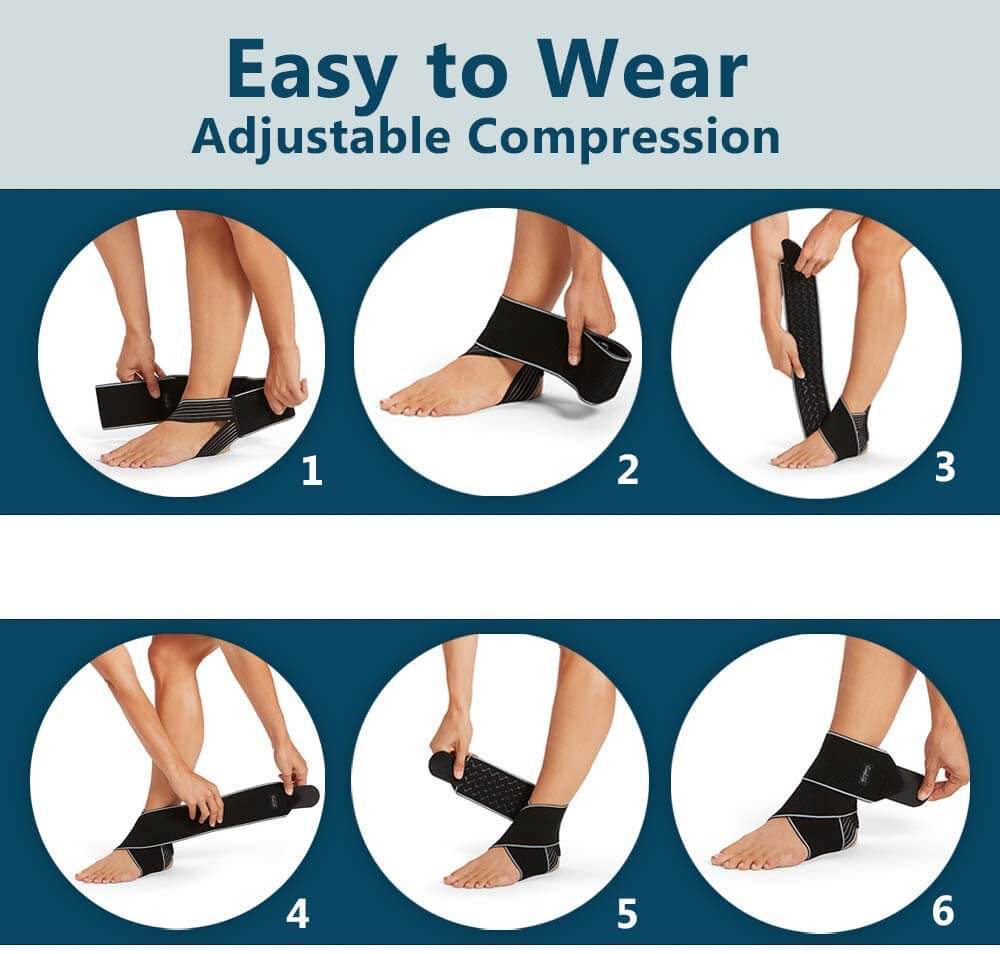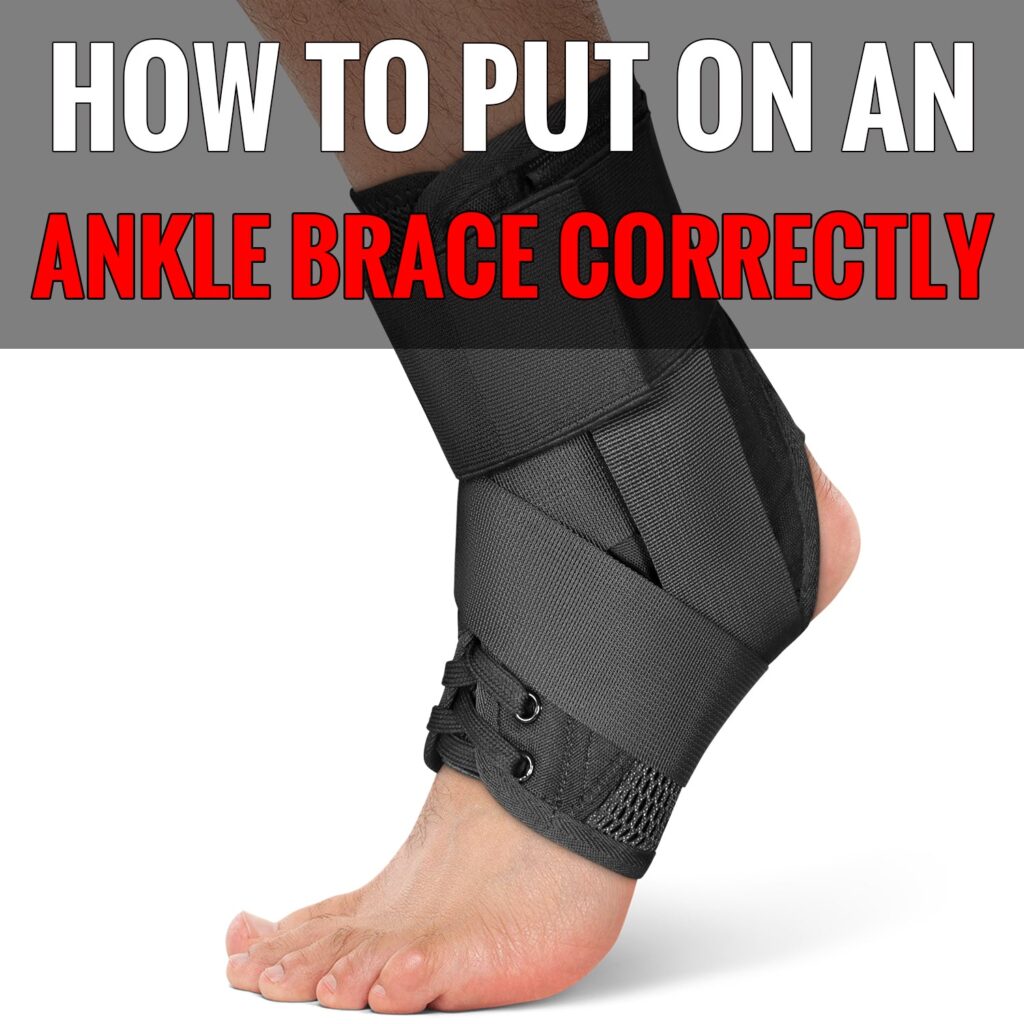To put on an ankle brace, first open all straps, laces, or Velcro closures. Slide your foot into the brace and adjust it snugly around your ankle and foot.
An ankle brace is a critical support device for those dealing with injuries or looking to prevent them during physical activity. Wearing one correctly is essential to ensure maximum stabilization and to promote healing. This seemingly simple task can be daunting, especially for first-timers or those in recovery.
How To Put On An Ankle Brace With Straps
The right technique in donning an ankle brace not only offers comfort but also ensures the brace functions effectively. Various styles of ankle braces exist, each with unique features suited for different needs—from lace-ups to sleeve types and those with rigid supports. Understanding your specific ankle brace design and following the manufacturer’s instructions will enhance the benefit it provides. Making sure your ankle brace fits well is a key component in your path to recovery or in your strategy to prevent injury during sports and other activities.

Credit: comfilife.com
Choosing The Right Ankle Brace
Finding the perfect ankle brace is key to your recovery and comfort.
An ideal ankle brace supports, compresses, and stabilizes. It helps heal injuries.
With multiple options available, the choice can be overwhelming.
Read on to take a closer look at what to consider.
Factors To Consider
- Size and fit: Ensure the brace fits snugly but doesn’t cut off circulation.
- Support level: Mild, moderate, or maximum support, match your activity.
- Material: Look for breathable, durable fabrics for comfort and longevity.
- Ease of use: Choose a brace you can put on and take off easily.
- Adjustability: Velcro straps or laces offer a customizable fit.
Types Of Ankle Braces
| Type | Best for | Features |
|---|---|---|
| Sleeve Brace | Mild support | Lightweight, compressive, easy to wear |
| Lace-Up Brace | Customizable fit | Adjustable laces, firmer support |
| Hinged Brace | Maximum stability | Rigid sides, allows ankle motion |
| Stirrup Brace | Post-injury | Gel or air cushioning, immobilization |
Always consult with a health professional before choosing a brace.
They can recommend the best one for your specific need. A proper brace aids recovery, prevent further injury.
Choose wisely and your ankles will thank you.
Preparing To Wear The Ankle Brace
Before you reap the benefits of an ankle brace, proper preparation is key. Strap in as we break down the simple steps to ensure your ankle gets the best support from your brace.
Gathering Necessary Items
Have everything you need within arm’s reach to streamline the process. Collect the following:
- Ankle brace: Choose the correct size and type for your needs.
- Socks: Thin, clean socks prevent irritation under the brace.
- Shoe: Ensure your shoe can accommodate the brace.
- Seating: Pick a comfortable place to sit while you apply the brace.
Positioning Your Foot
A correct start leads to the best finish. Position your foot for success:
- Sit in a stable and comfortable spot.
- Place your foot at a 90-degree angle.
- Ensure your foot is relaxed and not flexed.
A snug fit is a sign of a well-worn brace. Now your ankle is set for stellar support!
Steps To Secure The Ankle Brace
Ankle injuries can be quite common, especially among active individuals. Knowing how to properly secure an ankle brace is crucial in providing the necessary support and stabilization during both recovery and prevention of future injuries. Let’s walk through the easy-to-follow steps to ensure your ankle gets the protection it needs.
Aligning The Brace
Start by sitting in a comfortable position with your foot resting on a flat surface. Make sure your ankle is at a 90-degree angle. Open the brace and slide your foot into it. The heel should fit snugly into the brace’s heel cup. Align the brace so that it sits evenly on each side of your foot and ankle, ensuring it is not twisted.
- Place the foot flat on a stable surface.
- Ensure the heel sits in the brace’s heel cup.
- Align sides of the brace with the foot and ankle.
Fastening Straps Or Laces
Once the brace is aligned, it’s time to secure it. If your ankle brace has laces, start at the bottom and lace up as you would with a shoe. For a brace with straps, begin fastening from the bottom straps and work your way up. Each strap should be pulled firmly but comfortably around the ankle. Cross-check that straps or laces cannot cause discomfort or impede circulation.
| Laces | Straps |
|---|---|
| Start from the bottom and work up | Begin with bottom straps and secure upwards |
| Tighten so they fit snugly | Ensure firm but comfortable fit |
With these steps, your ankle brace should be securely fitted, allowing for optimal support without discomfort. A well-fitted ankle brace can effectively aid recovery and prevent future injuries, so take your time with each step to ensure the best fit!

Credit: m.youtube.com
Important Tips For A Proper Fit
Securing your ankle with the right brace ensures maximum support and promotes healing. Proper fit is critical in preventing further injury. Follow these crucial steps to ensure the best fit for your ankle brace.
Adjusting For Comfort
- Begin by opening all straps, laces, or Velcro closures.
- Slide your foot into the brace, placing the heel firmly against the brace’s heel cup.
- Align the brace so that it sits evenly on either side of the ankle.
- Sit down and place your foot at a 90-degree angle for optimal brace positioning.
- Slowly tighten the closures starting from the bottom, moving upwards for an even snugness.
- Walk around to assess comfort and adjust if there’s any pinching or discomfort.
Double-checking Tightness
- Press fingers along the edges of the brace to ensure it’s snug, not tight.
- Check the space by inserting a finger under the strap. A snug fit allows one finger only.
- Gently twist your ankle to test the brace’s resistance. Your movement should feel supported, but not restricted.
- Adjust the straps if the brace shifts or slides while walking.
- Reevaluate tightness after 15–20 minutes as the brace may settle and require a slight readjustment.
How To Put On An Ankle Brace With Laces
Post-application: Ensuring Effectiveness
After putting on an ankle brace correctly, it’s crucial to check its effectiveness. A well-fitted brace supports the ankle but doesn’t stop natural movement. Let’s test how well the brace works and ensure comfort throughout the day.
Testing Range Of Motion
Freedom of movement is essential for a healing ankle. With the brace on, gently rotate your ankle. You should be able to move without pain or restrictions. Perform these motions:
- Roll your ankle in a circular motion.
- Point your toes and then flex them back towards you.
- Walk a few steps to check for comfort while in motion.
If any movement feels wrong, adjust the brace straps for a better fit.
Wearing Socks And Shoes
Ankle braces work best alongside socks and shoes. Socks prevent rubbing and discomfort. Here’s the best way to layer them:
- Put on a thin sock before the ankle brace to protect your skin.
- After brace application, slide a second sock over the brace if needed for extra cushioning.
- Choose shoes with enough room to accommodate the brace.
The right sock and shoe can enhance the brace’s effectiveness.

Credit: www.youtube.com
Care And Maintenance Of Ankle Braces
Ankle braces are essential for support during recovery and sports activities. Proper care ensures they remain effective and hygienically safe. This guide covers essential tips for maintaining your ankle brace.
Cleaning Practices
Keeping your ankle brace clean is crucial for skin health and brace functionality. Follow these steps to clean your brace correctly:
- Remove any metal or hard plastic parts if possible.
- Use a mild soap and warm water to gently clean the fabric parts.
- Avoid bleach or other harsh chemicals that can degrade the material.
- For best results, hand wash and air dry your brace.
- Never machine dry as heat can warp the brace.
Brace Longevity And Storage
To extend the life of your ankle brace, consider these points:
| Do | Don’t |
|---|---|
| Store in a cool, dry place | Expose to direct sunlight |
| Keep fastened when not in use | Fold or crush, which can deform the brace |
| Inspect regularly for wear and tear | Ignore signs of damage |
Remember, proper storage prevents the brace from losing shape and function. Always follow the manufacturer’s guidelines for the best results.
Frequently Asked Questions For How To Put On An Ankle Brace
Can Ankle Braces Prevent Injury?
Ankle braces can provide support and reduce the risk of injury. They stabilize the joint and limit excessive movement, making them helpful, especially during physical activities. Consulting a medical professional is advised for injury-prone individuals.
What Types Of Ankle Braces Are Available?
Several types of ankle braces exist, including lace-ups, straps, and sleeves. Lace-ups offer customizable tightness; straps are adjustable for pressure, and sleeves provide compression. The choice depends on the required support level and personal comfort preference.
How Tight Should An Ankle Brace Be?
An ankle brace should be snug but not overly tight. Adequate tightness ensures support without hindering circulation or causing discomfort. A well-fitted brace will feel comfortable and maintain its position during movement.
What’s The Right Way To Wear An Ankle Brace?
To properly wear an ankle brace, start by ensuring the brace is open and ready to receive the foot. Slide the foot in, align the brace so it fits comfortably, and secure any straps or laces from bottom to top for even support.
Conclusion
Wrapping up, mastering ankle brace application is a breeze with practice. Remember these steps for secure and effective support. Perfect fit and comfort are paramount. Embrace your active lifestyle with confidence and ease. For more tips on injury prevention, stay tuned to our blog!



